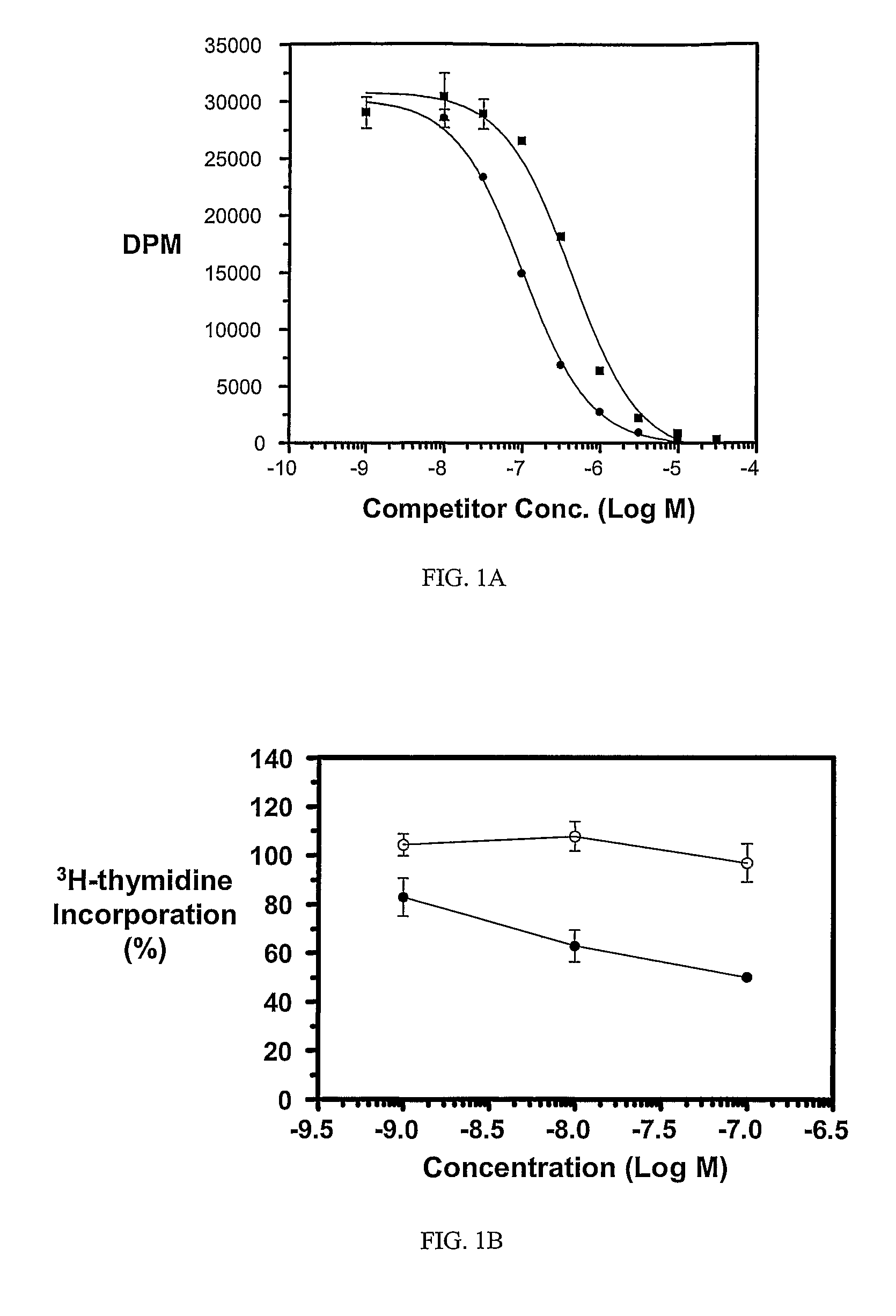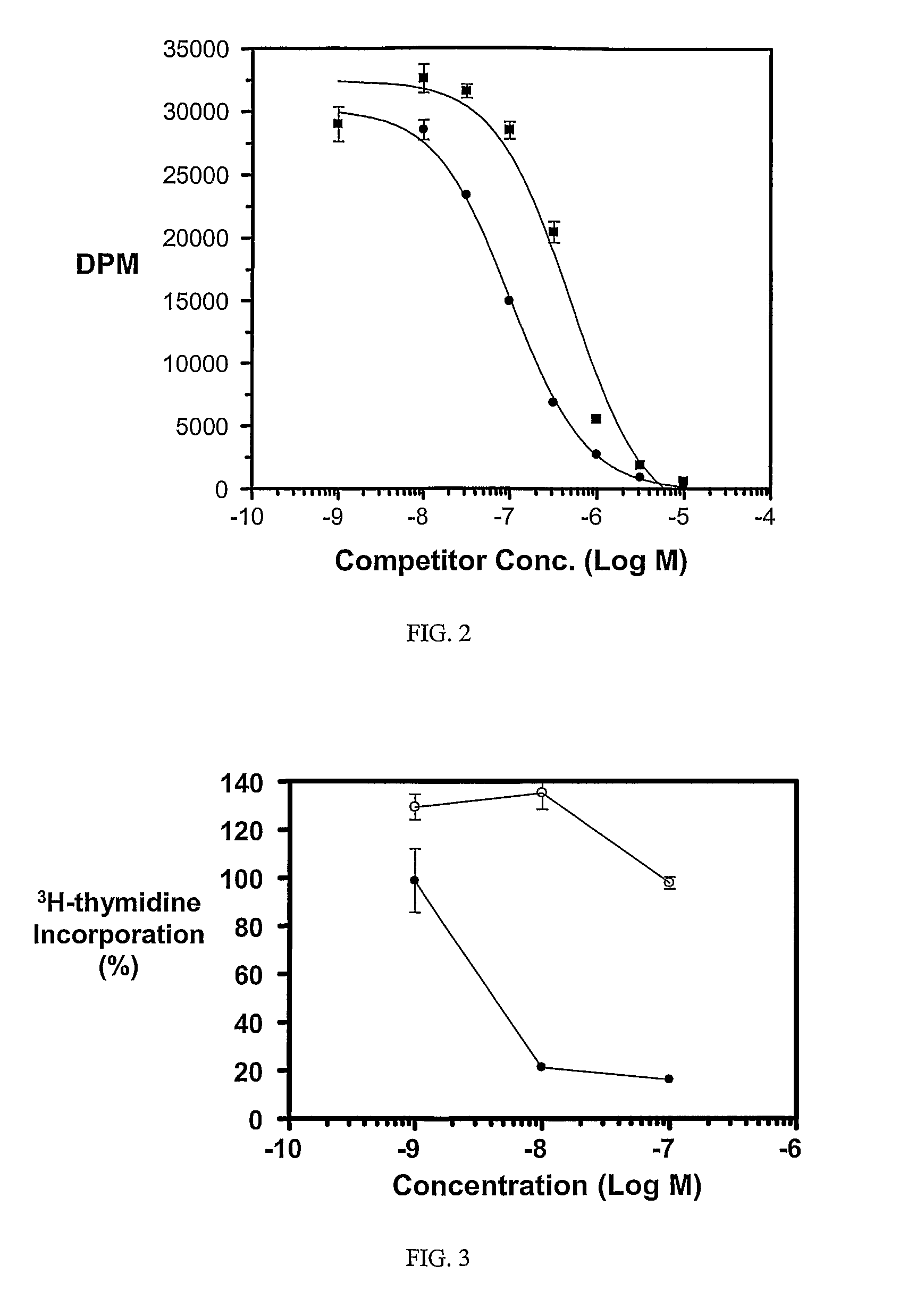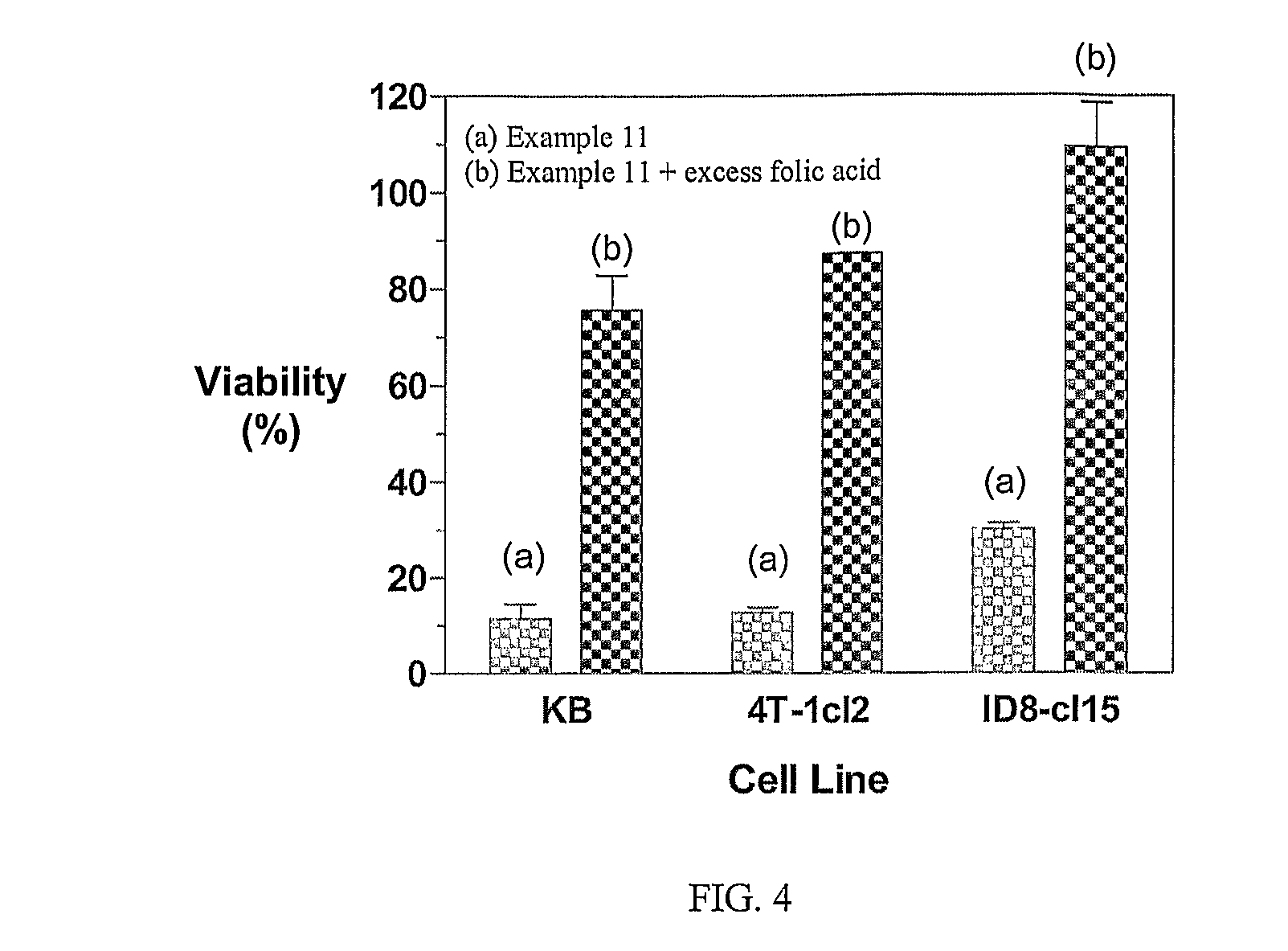Multi-drug ligand conjugates
a technology of conjugates and drugs, applied in the field of conjugates, can solve the problems of complex approaches, adverse side effects of many currently available chemotherapeutic agents and radiation therapy regimens,
- Summary
- Abstract
- Description
- Claims
- Application Information
AI Technical Summary
Benefits of technology
Problems solved by technology
Method used
Image
Examples
example 1
[0181]
According to the general procedure of Method Example 7 (Scheme 1), Wang resin bound 4-methoxytrityl (MTT)-protected Cys-NH2 was reacted according to the following sequence: 1) a. Fmoc-Asp(OtBu)-OH, PyBOP, DIPEA; b. 20% Piperidine / DMF; 2) a. Fmoc-Asp(OtBu)-OH, PyBOP, DIPEA; b. 20% Piperidine / DMF; 3) a. Fmoc-Arg(Pbf)-OH, PyBOP, DIPEA; b. 20% Piperidine / DMF; 4) a. Fmoc-Asp(OtBu)-OH, PyBOP, DIPEA; b. 20% Piperidine / DMF; 5) a. Fmoc-Glu-OtBu, PyBOP, DIPEA; b. 20% Piperidine / DMF; 6) N10-TFA-pteroic acid, PyBOP, DIPEA. The MTT, tBu, and Pbf protecting groups were removed with TFA / H2O / TIPS / EDT (92.5:2.5:2.5:2.5), and the TFA protecting group was removed with aqueous NH4OH at pH=9.3. Selected 1H NMR (D2O) δ (ppm) 8.68 (s, 1H, FA H-7), 7.57 (d, 2H, J=8.4 Hz, FA H-12 & 16), 6.67 (d, 2H, J=9 Hz, FA H-13 & 15), 4.40-4.75 (m, 5H), 4.35 (m, 2H), 4.16 (m, 1H), 3.02 (m, 2H), 2.55-2.95 (m, 8H), 2.42 (m, 2H), 2.00-2.30 (m, 2H), 1.55-1.90 (m, 2H), 1.48 (m, 2H); MS (ESI, m+H+) 1046.
example 2
[0182]
According to the general procedure of Method Example 7 (Scheme 1), Wang resin bound 4-methoxytrityl (MTT)-protected Cys-NH2 was reacted according to the following sequence: 1) a. Fmoc-3-aminoalanine(NH-MTT)-OH, PyBOP, DIPEA; b. 20% Piperidine / DMF; 2) a. Fmoc-Asp(OtBu)-OH, PyBOP, DIPEA; b. 20% Piperidine / DMF; 3) a. Fmoc-Asp(OtBu)-OH, PyBOP, DIPEA; b. 20% Piperidine / DMF; 4) a. Fmoc-Asp(OtBu)-OH, PyBOP, DIPEA; b. 20% Piperidine / DMF; 5) a. Fmoc-Glu-OtBu, PyBOP, DIPEA; b. 20% Piperidine / DMF; 6) N10-TFA-pteroic acid, PyBOP, DIPEA. The MTT, tBu, and TFA protecting groups were removed with a. 2% hydrazine / DMF; b. TFA / H2O / TIPS / EDT (92.5:2.5:2.5:2.5).
The reagents shown in the following table were used in the preparation:
[0183]
Reagent(mmol)equivalentsAmountH-Cys(4-methoxytrityl)-2-0.561 1.0 gchlorotrityl-Resin(loading 0.56 mmol / g)Fmoc-β-aminoalanine(NH-1.1220.653 gMTT)-OHFmoc-Asp(OtBu)-OH1.1220.461 gFmoc-Asp(OtBu)-OH1.1220.461 gFmoc-Asp(OtBu)-OH1.1220.461 gFmoc-Glu-OtBu1.1220.477 gN10TFA...
example 3
[0186]
According to the general procedure of Method Example 7 (Scheme 1), Wang resin bound 4-methoxytrityl (MTT)-protected Cys-NH2 was reacted according to the following sequence: 1) a. Fmoc-β-aminoalanine(NH-IvDde)-OH, PyBOP, DIPEA; b. 20% Piperidine / DMF; 2) a. Fmoc-Asp(OtBu)-OH, PyBOP, DIPEA; b. 20% Piperidine / DMF; 3) a. Fmoc-Asp(OtBu)-OH, PyBOP, DIPEA; b. 20% Piperidine / DMF; 4) a. Fmoc-Asp(OtBu)-OH, PyBOP, DIPEA; b. 20% Piperidine / DMF; 5) a. Fmoc-Glu-OtBu, PyBOP, DIPEA; b. 20% Piperidine / DMF; 6) N10-TFA-pteroic acid, PyBOP, DIPEA. The MTT, tBu, and TFA protecting groups were removed with a. 2% hydrazine / DMF; b. TFA / H2O / TIPS / EDT (92.5:2.5:2.5:2.5).
The reagents shown in the following table were used in the preparation:
[0187]
Reagent(mmol)EquivalentsAmountH-Cys(4-methoxytrityl)-2-0.561 1.0 gchlorotrityl-Resin(loading 0.56 mmol / g)Fmoc-β-aminoalanine(NH-1.1220.596 gIvDde)-OHFmoc-Asp(OtBu)-OH1.1220.461 gFmoc-Asp(OtBu)-OH1.1220.461 gFmoc-Asp(OtBu)-OH1.1220.461 gFmoc-Glu-OtBu1.1220.477 gN1...
PUM
| Property | Measurement | Unit |
|---|---|---|
| volume | aaaaa | aaaaa |
| pH | aaaaa | aaaaa |
| volume | aaaaa | aaaaa |
Abstract
Description
Claims
Application Information
 Login to View More
Login to View More - R&D
- Intellectual Property
- Life Sciences
- Materials
- Tech Scout
- Unparalleled Data Quality
- Higher Quality Content
- 60% Fewer Hallucinations
Browse by: Latest US Patents, China's latest patents, Technical Efficacy Thesaurus, Application Domain, Technology Topic, Popular Technical Reports.
© 2025 PatSnap. All rights reserved.Legal|Privacy policy|Modern Slavery Act Transparency Statement|Sitemap|About US| Contact US: help@patsnap.com



